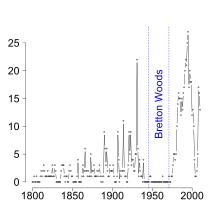Financial regulation
| Part of a series on financial services |
| Financial regulation |
|---|
| Finance |
|---|
 |
Financial regulation is a form of regulation or supervision, which subjects financial institutions to certain requirements, restrictions and guidelines, aiming to maintain the integrity of the financial system. This may be handled by either a government or non-government organization. Financial regulation has also influenced the structure of banking sectors, by decreasing borrowing costs and increasing the variety of financial products available.
Aims of regulation
The objectives of financial regulators are usually:[1]
- market confidence – to maintain confidence in the financial system
- financial stability – contributing to the protection and enhancement of stability of the financial system
- consumer protection – securing the appropriate degree of protection for consumers.
- reduction of financial crime – reducing the extent to which it is possible for a regulated business to be used for a purpose connected with financial crime.
- regulating foreign participation in the financial markets.
Structure of supervision
Acts empower organizations, government or non-government, to monitor activities and enforce actions.[2] There are various setups and combinations in place for the financial regulatory structure around the global.[3][4] Leaf parts are in any case:
Supervision of stock exchanges
Exchange acts ensure that trading on the exchanges is conducted in a proper manner. Most prominent the pricing process, execution and settlement of trades, direct and efficient trade monitoring.[5][6]
Supervision of listed companies
Financial regulators ensure that listed companies and market participants comply with various regulations under the trading acts. The trading acts demands that listed companies publish regular financial reports, ad hoc notifications or directors' dealings. Whereas market participants are required to Publish major shareholder notifications. The objective of monitoring compliance by listed companies with their disclosure requirements is to ensure that investors have access to essential and adequate information for making an informed assessment of listed companies and their securities.[7][8][9]
Supervision of investment management
Asset management supervision or investment acts ensures the frictionless operation of those vehicles.[10]
Supervision of banks and financial services providers
Banking acts lay down rules for banks which they have to observe when they are being established and when they are carrying on their business. These rules are designed to prevent unwelcome developments that might disrupt the smooth functioning of the banking system. Thus ensuring a strong and efficient banking system.[11][12]
Authority by country

The following is a short listing of regulatory authorities in various jurisdictions, for a more complete listing, please see list of financial regulatory authorities by country.
- United States
- U.S. Securities and Exchange Commission (SEC)
- Financial Industry Regulatory Authority (FINRA)
- Commodity Futures Trading Commission (CFTC)
- Federal Reserve System ("Fed")
- Federal Deposit Insurance Corporation (FDIC)
- Office of the Comptroller of the Currency (OCC)
- National Credit Union Administration (NCUA)
- Office of Thrift Supervision (OTS) (dissolved in 2011)
- Consumer Financial Protection Bureau (CFPB)
- United Kingdom
- Bank of England (BoE)
- Prudential Regulation Authority (PRA)
- Financial Conduct Authority (FCA)
- Financial Services Agency (FSA), Japan
- Federal Financial Supervisory Authority (BaFin), Germany
- Autorité des marchés financiers (France) (AMF), France
- Monetary Authority of Singapore (MAS), Singapore
- Swiss Financial Market Supervisory Authority (FINMA), Switzerland
- People's Republic of China
Unique jurisdictions
In most cases, financial regulatory authorities regulate all financial activities. But in some cases, there are specific authorities to regulate each sector of the finance industry, mainly banking, securities, insurance and pensions markets, but in some cases also commodities, futures, forwards, etc. For example, in Australia, the Australian Prudential Regulation Authority (APRA) supervises banks and insurers, while the Australian Securities and Investments Commission (ASIC) is responsible for enforcing financial services and corporations laws.
Sometimes more than one institution regulates and supervises the banking market, normally because, apart from regulatory authorities, central banks also regulate the banking industry. For example, in the USA banking is regulated by a lot of regulators, such as the Federal Reserve System, the Federal Deposit Insurance Corporation, the Office of the Comptroller of the Currency, the National Credit Union Administration, the Office of Thrift Supervision, as well as regulators at the state level.[14]
In the European Union, the European System of Financial Supervision consists of the European Banking Authority (EBA), the European Securities and Markets Authority (ESMA) and the European Insurance and Occupational Pensions Authority (EIOPA) as well as the European Systemic Risk Board. The Eurozone countries are forming a Single Supervisory Mechanism under the European Central Bank as a prelude to Banking union.
In addition, there are also associations of financial regulatory authorities. At the international level, there is the International Organization of Securities Commissions (IOSCO), the International Association of Insurance Supervisors, the Basel Committee on Banking Supervision, the Joint Forum, and the Financial Stability Board, where national authorities set standards through consensus-based decision-making processes.[15]
The structure of financial regulation has changed significantly in the past two decades, as the legal and geographic boundaries between markets in banking, securities, and insurance have become increasingly "blurred" and globalized.
Regulatory reliance on credit rating agencies
Think-tanks such as the World Pensions Council (WPC) have argued that most European governments pushed dogmatically for the adoption of the Basel II recommendations, adopted in 2005, transposed in European Union law through the Capital Requirements Directive (CRD), effective since 2008. In essence, they forced European banks, and, more importantly, the European Central Bank itself e.g. when gauging the solvency of EU-based financial institutions, to rely more than ever on the standardized assessments of credit risk marketed by two private US agencies- Moody’s and S&P, thus using public policy and ultimately taxpayers’ money to strengthen an anti-competitive duopolistic industry.
See also
- Bank regulation
- Finance
- Financial repression
- Global financial system
- Group of Thirty
- Insurance law
- International Organization of Securities Commissions
- International Centre for Financial Regulation
- LabEx ReFi - European Laboratory on Financial Regulation
- Regulatory capture
- Securities Commission
- Regulation of commodity markets
- Virtual currency law in the United States
References
- ↑ UK FSA statutory objectives
- ↑ What is Financial Regulation Trying to Achieve?, Riccardo De Caria
- ↑ Luxembourg CSSF structure and organisation
- ↑ German BAFin supervision organisation
- ↑ Suisse finma stock exchange supervision
- ↑ German BAFin stock exchange supervision
- ↑ Finland FSA supervion of listed companies
- ↑ Saudi Arabia market supervision
- ↑ Borsa Italiana listed stock supervision
- ↑ US SEC Division of Investment Management
- ↑ Reserve Bank of India, Department of Banking Supervision
- ↑ Luxembourg CSSF Supervision of Banks
- ↑ Works, Anchor Media. "This Time is Different - A Book by Carmen M. Reinhart and Kenneth S. Rogoff". reinhartandrogoff.com.
- ↑ "list of state banking authorities". State Banking Authorities. Consumer Action Website. Retrieved August 5, 2011.
- ↑ Prabhakar, Rahul (1 June 2013). "Varieties of Regulation: How States Pursue and Set International Financial Standards". Oxford University GEG. Retrieved 7 August 2015.
Further reading
- Ely, Bert (2008), "Financial Regulation", in David R. Henderson (ed.), Concise Encyclopedia of Economics (2nd ed.), Indianapolis: Library of Economics and Liberty, ISBN 978-0865976658, OCLC 237794267
- Reinhart, Carmen; Rogoff, Rogoff (2009), This Time is Different: Eight Centuries of Financial Folly, Princeton U. Pr., ISBN 978-0-691-15264-6
- Simpson, D., Meeks, G., Klumpes, P., & Andrews, P. (2000). Some cost-benefit issues in financial regulation. London: Financial Services Authority.
External links
- Securities Lawyer's Deskbook from the University of Cincinnati College of Law
- FINRA Information
- The Compliance Exchange Jonathan Halsey's financial regulation research resource
- ICFR (The International Centre for Financial Regulation)
- Ana Carvajal, Jennifer Elliott: IMF Study Points to Gaps in Securities Market Regulation
- IOSCO: Objectives and Principles of Securities Regulation (PDF-Datei 67 Seiten)
- The Samuel & Ronnie Heyman Center on Corporate Governance The Samuel & Ronnie Heyman Center on Corporate Governance
- The Institute for Financial Market Regulation The Institute for Financial Market Regulation